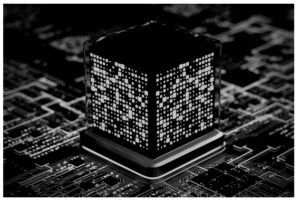REVOLUTIONISING LAW ENFORCEMENT WITH QUANTUM COMPUTING AND EDGE COMPUTING

In recent years, the use of quantum computing and edge computing has been gaining momentum in various industries, including law enforcement. The potential of these technologies is vast, and they can revolutionize the way law enforcement agencies operate and process data.

Although no Hollywood movie has explicitly focused on quantum and edge computing to stop crime or prevent an incident, there are a few movies that incorporated elements of quantum computing and edge computing in their plot. For instance, “The Imitation Game” (2014), tells the story of mathematician Alan Turing and his team’s efforts to crack the Nazi Enigma code during World War II. While the movie doesn’t explicitly mention quantum computing, it does touch on some of the foundational concepts that
make quantum computing so powerful, such as the idea of using probabilities to break codes. While “Eagle Eye” (2008) touches on Edge computing. In the movie, the US government uses a supercomputer called “Aria” to monitor all forms of communication to prevent terrorist attacks. While Aria isn’t explicitly referred to as an “edge” computer, it does incorporate many of the same principles, such as distributed processing and real-time data analysis.

A Climax Scene from Eagle Eye Movie
Quantum computing and edge computing have the potential to revolutionize various industries, including law enforcement. Here are some potential use cases for these technologies in policing:
- Quantum Computing: Quantum computing can be used to solve complex optimization problems that are beyond the capabilities of classical computers. In law enforcement, this can be used to analyze large datasets, such as crime statistics, and identify patterns and correlations that may not be apparent using traditional data analysis methods.
- Edge Computing: Edge computing involves processing data near the source of the data, rather than sending it to a centralized data centre. This can significantly reduce the latency and improve the responsiveness of real-time applications. In law enforcement, this can be used to process data from surveillance cameras or other sensors in real time, allowing law enforcement agencies to respond more quickly to potential threats.
- Predictive Policing: Both quantum computing and edge computing can be used to improve predictive policing, which uses data analysis to predict where crimes are likely to occur. Quantum computing can be used to analyze vast amounts of data, such as social media posts or weather patterns, to identify patterns and correlations that may not e visible using traditional data analysis methods. Edge computing can be used to process data in real time, allowing law enforcement agencies to respond quickly to potential threats.
- Cybersecurity: Both quantum computing and edge computing can be used to improve cybersecurity for law enforcement agencies. Quantum computing can be used to develop new encryption methods that are resistant to attacks by quantum computers. Edge computing can be used to process data locally, reducing the risk of sensitive data being intercepted during transmission to a centralized data centre.
It’s worth noting that both quantum computing and edge computing are still emerging technologies and their potential applications in law enforcement are still being explored. However, these technologies have the potential to transform the way law enforcement agencies operate and improve public safety.

Law enforcement is an increasingly complex field that requires the analysis of large datasets and the ability to respond to real-time events. Quantum computing and edge computing present exciting opportunities for revolutionizing policing in the future.
The potential applications of quantum computing and edge computing in law enforcement are numerous. For example, these technologies can be used to analyze surveillance footage in real-time and detect suspicious behaviour, as well as to analyze vast amounts of data from the Internet of Things (IoT) devices to identify suspicious patterns of activity. In addition, these technologies can be used to develop predictive models that can help law enforcement anticipate and prepare for criminal activities.
Overall, quantum computing and edge computing have the potential to revolutionize law enforcement in the future. By enabling the analysis of vast datasets and reducing latency, these technologies can provide law enforcement with the tools they need to effectively and efficiently tackle the challenges they face.
WHAT IS QUANTUM COMPUTING?

Quantum computing is a type of computing that uses quantum-mechanical phenomena, such as superposition and entanglement, to perform calculations. It operates on the principles of quantum mechanics and is capable of processing large amounts of data at a much faster rate than traditional computers. Quantum computers are capable of solving problems that traditional computers cannot, giving them an unprecedented level of computing power.
Quantum computing is a relatively new technology and is still in the early stages of development, but it has the potential to revolutionize the way we process data and solve complex problems. Quantum computers can be used for a wide range of applications, including artificial intelligence, machine learning, cryptography, and data analysis.
WHAT IS EDGE COMPUTING?

Edge computing is a type of distributed computing that relies on edge devices, such as smartphones, tablets, or computers, to process data. It is capable of processing data quickly and securely and is ideal for applications that require low latency or data security. Edge computing is becoming increasingly popular in the IoT (Internet of Things) world, as it allows for data to be processed at the edge of the network, rather than in a centralized location.
Edge computing is also being used in law enforcement. It allows for data to be processed quickly and securely, and can help law enforcement agencies make faster, better-informed decisions. It also helps reduce the strain on centralized data centres by allowing for data to be processed at the edge of the network.
BENEFITS OF USING QUANTUM COMPUTING AND EDGE COMPUTING FOR LAW ENFORCEMENT
There are many benefits of using quantum computing and edge computing for law enforcement. One of the most significant benefits is the ability to process large amounts of data quickly and securely. Quantum computing is capable of solving complex problems that traditional computers cannot, and it can help law enforcement agencies make better-informed decisions.

Edge computing can also be beneficial for law enforcement, as it allows for data to be processed quickly and securely at the edge of the network. This can be particularly useful for applications that require low latency or data security. Edge computing can also help reduce the strain on centralized data centres, as it allows for data to be processed at the edge of the network.
Quantum computing and edge computing can also help law enforcement agencies save time and money. By using these technologies, law enforcement agencies can reduce the amount of time and resources needed to process data, allowing them to focus on more important tasks. Additionally, quantum computing and edge computing can help law enforcement agencies reduce their operational costs, as they are more efficient and cost-effective than traditional methods.
Finally, quantum computing and edge computing can help law enforcement agencies improve the accuracy of their investigations. By using these technologies, law enforcement agencies can make better-informed decisions and reduce the risk of errors.
HOW QUANTUM COMPUTING AND EDGE COMPUTING CAN HELP FIGHT CYBERCRIME.
Cybercrime is one of the biggest threats facing law enforcement agencies today. It is a rapidly growing problem, and law enforcement agencies are struggling to keep up with the increasing number of cybercrimes. Fortunately, quantum computing and edge computing can help law enforcement agencies fight cybercrime.

Quantum computing can be used to analyze large amounts of data quickly and accurately, allowing law enforcement agencies to detect patterns and anomalies in a fraction of the time it would take with traditional methods. This can be used to identify potential cybercriminals and their networks, as well as detect and prevent cyberattacks.
Edge computing can also be used to help law enforcement agencies fight cybercrime. By using edge devices, such as smartphones and tablets, law enforcement agencies can process data quickly and securely at the edge of the network. This can be used to identify and monitor potential cyber criminals and can help law enforcement agencies identify and prevent cyberattacks.
HOW QUANTUM COMPUTING AND EDGE COMPUTING CAN PREVENT TERRORISM
Terrorism is a significant threat to law enforcement agencies, and they are constantly looking for new ways to prevent it. Fortunately, quantum computing and edge computing can help law enforcement agencies prevent terrorism.

Quantum computing can be used to analyze large amounts of data quickly and accurately, allowing law enforcement agencies to detect patterns and anomalies in a fraction of the time it would take with traditional methods. This can be used to identify potential terrorists and their networks, as well as detect and prevent terrorist attacks. Edge computing can also be used to help law enforcement agencies prevent terrorism. By using edge devices, such as smartphones and tablets, law enforcement agencies can process data quickly and securely at the edge of the network. This can be used to identify and monitor potential terrorists and can help law enforcement agencies identify and prevent terrorist attacks.
HOW QUANTUM AND EDGE COMPUTING CAN HELP IN FIGHTING CRIME?
Crime is a major problem for law enforcement agencies, and they are constantly looking for new ways to combat it. Fortunately, quantum computing and edge computing can help law enforcement agencies fight crime.

Quantum computing can be used to analyze large amounts of data quickly and accurately, allowing law enforcement agencies to detect patterns and anomalies in a fraction of the time it would take with traditional methods. This can be used to identify potential criminals and their networks, as well as detect and prevent criminal activity. Edge computing can also be used to help law enforcement agencies fight crime. By using edge devices, such as smartphones and tablets, law enforcement agencies can process data quickly and securely at the edge of the network. This can be used to identify and monitor potential criminals and can help law enforcement agencies identify and prevent criminal activity.
CHALLENGES OF USING QUANTUM AND EDGE COMPUTING FOR LAW ENFORCEMENT
Although quantum computing and edge computing can be beneficial for law enforcement, there are some challenges associated with using them. One of the biggest challenges is the cost. Quantum computing and edge computing are expensive technologies, and law enforcement agencies may not have the budget to invest in them. Additionally, quantum computing and edge computing are still relatively new technologies, and law enforcement agencies may not have the necessary expertise to use them effectively.
Another challenge is privacy and security. Law enforcement agencies must be careful when using quantum computing and edge computing, as these technologies can be used to access sensitive data and invade people’s privacy. Law enforcement agencies must ensure that they use these technologies responsibly and comply with all relevant privacy laws.

Finally, quantum computing and edge computing can be difficult to implement. Law enforcement agencies must ensure that they have the necessary infrastructure in place to use these technologies effectively. Additionally, law enforcement agencies must ensure that they have the necessary expertise to use these technologies, as they can be difficult to understand and use properly.
CONCLUSION
In conclusion, quantum computing and edge computing can revolutionize the way law enforcement agencies operate and process data. These technologies can help law enforcement agencies fight cybercrime, prevent terrorism, and fight crime, as well as save time and money. Additionally, there are many courses and services available to help law enforcement agencies learn and use these technologies effectively. The potential of quantum computing and edge computing is vast, and it is only a matter of time before these technologies become commonplace in law enforcement. As law enforcement agencies become more familiar with these technologies, they will be able to use them more effectively and efficiently.
Quantum computing can be used to solve complex optimization problems that are beyond the capabilities of classical computers. In law enforcement, this can be used to analyze large datasets, such as crime statistics, and identify patterns and correlations that may not be apparent using traditional data analysis methods. This could allow law enforcement to more quickly and accurately identify suspects and solve crimes. Additionally, quantum computing can be used for predictive analytics. By analyzing past data, law enforcement may be able to predict where and when certain types of crimes are likely to occur.
Edge computing involves processing data near the source of the data, rather than sending it to a centralized data centre. This can significantly reduce the latency and improve the responsiveness of real-time applications. In law enforcement, this can be used to enhance surveillance capabilities, such as facial recognition, as well as to improve the accuracy of tracking, tracing, and locating suspects.

The potential applications of quantum computing and edge computing in law enforcement are virtually limitless. In the future, these technologies could revolutionize the way law enforcement agencies operate. From predictive analytics to enhanced surveillance capabilities, these technologies could help law enforcement agencies to be more efficient, effective, and accurate in their investigations.
 Dr K. Jayanth Murali is a retired IPS officer and a Life Coach. He is the author of four books, including the best-selling 42 Mondays. He is passionate about painting, farming, and long-distance running . He has run several marathons and has two entries in the Asian book of Records in full and half marathon categories. He lives with his family in Chennai, India. When he is not running, he is either writing or chilling with a book.
Dr K. Jayanth Murali is a retired IPS officer and a Life Coach. He is the author of four books, including the best-selling 42 Mondays. He is passionate about painting, farming, and long-distance running . He has run several marathons and has two entries in the Asian book of Records in full and half marathon categories. He lives with his family in Chennai, India. When he is not running, he is either writing or chilling with a book.
